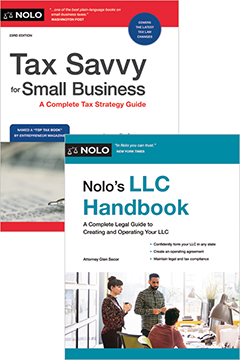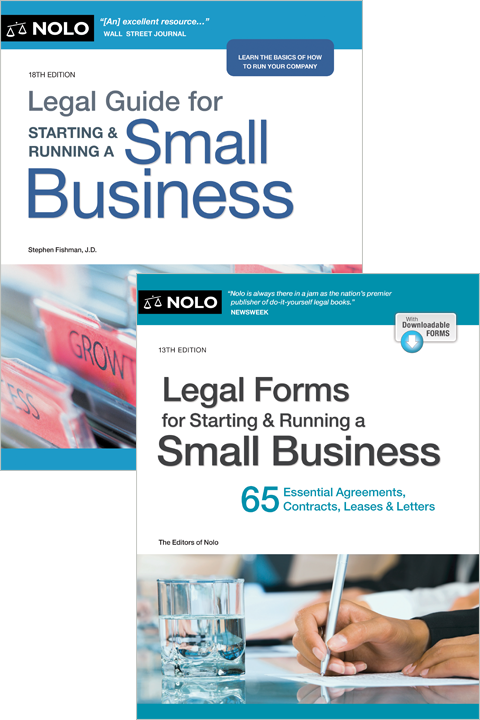Learn about the legal and tax issues involved when you convert a limited liability company to a corporation or S corp.
The process for converting your small business from a limited liability company (LLC) to a corporation will vary depending on multiple factors. While we can't cover every possible variation, here's a quick look at some of the more basic issues for this type of conversion.
- Why Businesses Convert LLCs to Corporations
- Different Elements of Conversions
- Three Types of LLC to Corporation Conversions
- The IRS's Approach to Transfers of Assets and Interests
- Converting an LLC to an S Corporation
- Change in Tax Status ("Check-the-Box")
- State-Specific Considerations and Requirements
- What to Do After Filing Your Conversion Paperwork
- Getting Help With Converting Your LLC to a Corporation
Why Businesses Convert LLCs to Corporations
Sometimes forming an LLC makes the most sense for your business at the start. But over time, your business grows and changes, and so should your business structure. LLCs are one of the most adaptable entities. They offer limited liability for their owners (called "members") and flexible tax and management structures.
However, while an LLC is often a great choice for business owners, investors usually prefer to invest in corporations. Investors prefer corporations for several reasons.
Corporations offer more investment opportunities, such as different types of stock, and they give shareholders the most protection. Also, corporations have formalities—many of them required by state law—that provide investors with a transparent picture of how the business is run.
Outside of what investors prefer, you might want to give your employees different compensation packages. Having a corporation allows you to offer employees stock options, which can attract top candidates to your business.
Moreover, converting to an S corporation gives you the limited liability and formalities of a corporation, but similar tax advantages to an LLC. An S corporation is a pass-through tax entity—like an LLC but unlike a regular corporation. So, the corporation itself isn't taxed. Only the shareholders are taxed on the money they receive from the corporation as dividends (or as a salary if they're an employee of the corporation). You can only convert to an S corporation after you've converted to a regular corporation—also known as a "C corporation."
For more, read about the differences between LLCs and corporations.
Different Elements of Conversions
First, there isn't just one tax status for an LLC, one kind of corporation, or one kind of conversion. On the contrary, there are:
- LLCs taxed as partnerships, LLCs taxed as corporations, and LLCs taxed as "disregarded entities"
- C corporations (that pay corporate taxes) and S corporations (that have pass-through taxation so that only the shareholders pay taxes); and
- multiple methods for converting your business—including statutory conversions, statutory mergers, and nonstatutory conversions.
With these variables in mind, it's important to understand the differences in business and tax structures and in conversion methods. For example, converting an LLC taxed as a partnership to a C corporation through a statutory merger is fundamentally different—both in terms of tax consequences and required paperwork—from converting an LLC taxed as a corporation to an S corporation through a statutory conversion.
Here we'll try to simplify matters and look mainly at multi-member LLCs taxed as partnerships converting to closely-held C corporations.
Three Types of LLC to Corporation Conversions
There are three types of conversion methods that states recognize. You should check your state's business laws to see which type of conversions your state allows.
Statutory Conversion
A statutory conversion is a relatively new, streamlined procedure that's available in many states. This method allows you to convert your LLC to a corporation by filing a few forms with the secretary of state's office. Each state that allows statutory conversions has its own specific forms and rules.
However, generally speaking, steps for a statutory conversion include:
- prepare a plan of conversion
- have your plan approved by the LLC members; and
- file articles of conversion—sometimes called a "certificate of conversion"—and, as necessary, articles of incorporation (and other legally required documents) with the secretary of state or another filing office.
While there are important technical distinctions between a statutory conversion and other types of conversions, the practical effects are the same:
- people who were LLC members are now stockholders in your new corporation
- the assets and liabilities of your LLC are now assets and liabilities of your new corporation, and
- your LLC ceases to exist.
A key point about statutory conversions is that all these effects occur automatically by operation of law rather than through separate, formal agreements. Though you should still address how LLC interests will be exchanged for stock in either your plan of conversion or in a separate agreement.
Statutory conversion is usually the quickest and most inexpensive way to convert from an LLC to a corporation. In those states where it's available, this type of conversion will generally be your best option.
Statutory Merger
A statutory merger is more complicated than a statutory conversion. However, if your state doesn't allow for statutory conversions, you'll likely use this method. While specific details will vary from state to state, the basic steps of a statutory merger usually include:
- form a new corporation (which means your LLC members will now also be corporation stockholders)
- have the LLC members vote to approve the merger both in their roles as LLC members and as corporation stockholders
- have the LLC members formally exchange their membership rights for shares in the corporation; and
- file a certificate of merger and other legally required documents with the secretary of state.
Like with a statutory conversion, a statutory merger automatically transfers your LLC's assets and liabilities to the new corporation by operation of law. However, unlike statutory conversions, you have to create your new corporation as a separate business entity before that transfer can occur—a process that involves multiple steps and fees. Additionally, you'll need to formally exchange membership rights for corporate shares through a merger agreement.
You'll also likely have to file a form that formally dissolves your LLC.
Nonstatutory Conversion
Nonstatutory conversion is generally the most complicated and expensive way to convert from an LLC to a corporation. Very briefly, the main steps are:
- form a new corporation
- formally transfer your LLC's assets and liabilities to the corporation
- formally arrange the exchange of LLC membership interests for corporation shares; and
- formally liquidate and dissolve the corporation.
Unlike the two preceding conversion methods, under nonstatutory conversion, your LLC's assets and liabilities aren't automatically transferred to the new corporation. Instead, in a nonstatutory conversion, you'll need one or more special agreements to exchange LLC membership interests for corporate shares and to transfer assets and liabilities.
There are multiple methods for handling these transfers and exchanges. If you need to go through a nonstatutory conversion, you'll need expert legal assistance. However, in most cases, you should be able to avoid using this approach.
The IRS's Approach to Transfers of Assets and Interests
In Revenue Ruling 84-111, the IRS briefly describes three more specific methods of converting an LLC to a corporation when using nonstatutory conversion. Each of these three methods has a shorthand name, as follows:
- "Assets-over" conversion: The LLC transfers all of its assets and liabilities to the newly-formed corporation in exchange for all outstanding stock of the corporation. The LLC is terminated by distributing all of the corporation's stock to the LLC members. (This conversion is called "assets-over" because assets are transferred "over" to the new corporation.)
- "Assets-up" conversion: The LLC distributes all of its assets and liabilities to its members to terminate the LLC. Then the members transfer all the assets received from the LLC to the corporation in exchange for all outstanding stock of the corporation plus the corporation's assumption of all of those LLC liabilities that previously had been assumed by the LLC's members. (This method is called "assets-up" because, after LLC assets are transferred "down" to LLC members, they're ultimately transferred "up" to the new corporation.)
- "Interests-over" conversion: The LLC members transfer their LLC interests to the newly-formed corporation in exchange for all the outstanding stock of the corporation. The LLC is terminated with all of the LLC assets and liabilities becoming assets and liabilities of the corporation. (This conversion is called "interests-over" because LLC members transfer their "interests over" to the new corporation.)
Revenue Ruling 84-111 doesn't address how the IRS views statutory conversions or statutory mergers. However, a 2004 IRS bulletin clarifies that, for federal tax purposes, the IRS will treat these types of conversions as essentially the same as the first conversion method listed just above ("assets-over").
Each of the three transfer methods described by the IRS has its own particular tax consequences. If you have questions about the legal and tax implications of converting your business, you should consult with a tax attorney.
Converting an LLC to an S Corporation
If you want to convert your LLC to an S corporation, then you'll need to take additional steps apart from converting your business to a corporation. An S corporation is a regular corporation (or another entity treated as a corporation) that has elected "S corporation" tax status. Convert your LLC at the state level, and elect to have your business taxed as an S corporation.
You'll probably need your new corporation's directors or shareholders to approve of the S corporation election. Check your articles of incorporation or bylaws for the required procedure.
Once you have the appropriate approval, you can file an IRS Form 2553.
For additional guidance on electing S corporation tax status, check out the S corporation tax filing requirements.
Change in Tax Status ("Check-the-Box")
Our main concern here is converting the legal form of your business from an LLC to a corporation. However, if you don't want to convert your LLC to a corporation but simply want your business to be taxed as a corporation—instead of as a partnership—you only need to file IRS Form 8832. There's no need to convert your LLC to a corporation at the state level.
By default, the IRS taxes a multi-member LLC as a partnership and a single-member LLC as a so-called "disregarded entity." There's no separate IRS tax category for LLCs.
While the IRS forms for changing tax status are fairly straightforward, this procedure—known as "Check-the-Box"—involves special eligibility criteria. You can find those criteria in the instructions included with the forms. Generally speaking, your LLC should be eligible to file either Form 8832 or Form 2553, but you should consult with a tax expert for more details.
The specific tax consequences for LLC-to-corporation conversions vary from one case to the next. Because the tax consequences can sometimes be significant, you should consult with a tax adviser before undertaking any conversion.
For more information, read how corporations are taxed.
State-Specific Considerations and Requirements
Every state has different requirements for converting an LLC to a corporation. Check your state's business laws for specific rules. For instance, California, Delaware, Florida, and Texas allow for statutory conversions while New York allows for statutory mergers. You can find state-specific articles on this topic in our section on changing business structure.
While some states have simple forms to fill out, other states don't provide any forms. It's simply up to the filer to create articles of conversion or articles of incorporation. If you need help drafting these documents, talk to a business attorney. They can draft these articles for you or review any documents you draft yourself.
For more information on differences between states, read about where to incorporate your business.
What to Do After Filing Your Conversion Paperwork
Regardless of which method you use to change the legal form of your LLC, you still need to take care of all the tasks normally associated with creating a new corporation. After filing your paperwork to convert your LLC to a corporation and submitting your articles of incorporation, you'll need to:
- draft corporate bylaws
- elect corporate officers and appointing corporate directors
- hold an initial board meeting, and
- issue stock certificates.
Also, although various IRS guidance isn't entirely clear, you might need to obtain a new employer identification number (EIN) as part of the conversion process.
One other key step in the conversion process is to make sure that no business contracts will be affected by your business's entity change. Make sure you check your business's:
- bank documents
- loan agreements
- commercial lease agreements
- licenses and permits, and
- insurance policies.
While converting to a corporation might not affect these agreements, you still might need to notify the other party of your entity change. Check the language of the agreement to see if there's a provision that requires such notification.
Getting Help With Converting Your LLC to a Corporation
Converting your LLC to a corporation can be fairly straightforward or it can quickly become complicated depending on your circumstances and your state of filing. It's critical that you choose the right conversion method and that you complete all of the initial and follow-up paperwork to validate the conversion.
You'll also need to follow all the required formalities for creating and maintaining a corporation to ensure that your business continues to have limited liability. Many business owners will benefit from speaking with a tax adviser or business attorney at some point in the conversion process. An attorney can convert your LLC to a corporation for you, or they can direct you toward your state's filing requirements and you can complete the process yourself.
For a more complete discussion of the steps involved in running a business, check out Nolo's Start & Run a Business Bundle.
- Why Businesses Convert LLCs to Corporations
- Different Elements of Conversions
- Three Types of LLC to Corporation Conversions
- The IRS’s Approach to Transfers of Assets and Interests
- Converting an LLC to an S Corporation
- Change in Tax Status (“Check-the-Box”)
- State-Specific Considerations and Requirements
- What to Do After Filing Your Conversion Paperwork
- Getting Help With Converting Your LLC to a Corporation



